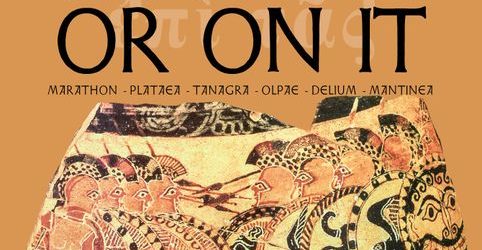By Paul Comben:
How precisely armies of hoplites fought their battles has engendered a significant amount of detailed study. For the student of military history, this is probably one of those marmite subjects – something you love, or something you will leave alone. However, even those schools of thought that incline towards assigning a somewhat greater amount of sophistication to these armies and their practice of arms are hardly equating them with the zenith of Rome’s legions or the shifty evolutions of Hannibal’s “all-the-talents” host on the field of Cannae.
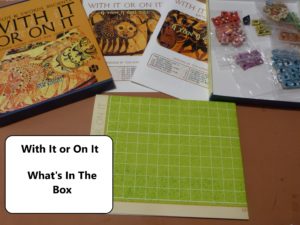 To come straight to the point (perhaps literally given what is to follow) what these armies did was find a field, line up, and then bang into each other. Yes, you can muse forever regarding Greek social structures, mores, and how these fed into the nature of the hoplite warrior; you can study the politics of individual Greek states and the machinations of one state or alliance plotting against its present enemy, and you can read book after book about how much running and “drifting” these armies did as each warrior sought the protection of the shield being carried by the man to their right. This is all rarefied stuff and is perhaps encouraged to be so because precisely who did what on these fields of conflict is a matter largely unknown. So maybe the academics compensate by ramping up the esoteric conundrums simply because you can write more on those than on the sequencing of manoeuvres once the fight got underway?
To come straight to the point (perhaps literally given what is to follow) what these armies did was find a field, line up, and then bang into each other. Yes, you can muse forever regarding Greek social structures, mores, and how these fed into the nature of the hoplite warrior; you can study the politics of individual Greek states and the machinations of one state or alliance plotting against its present enemy, and you can read book after book about how much running and “drifting” these armies did as each warrior sought the protection of the shield being carried by the man to their right. This is all rarefied stuff and is perhaps encouraged to be so because precisely who did what on these fields of conflict is a matter largely unknown. So maybe the academics compensate by ramping up the esoteric conundrums simply because you can write more on those than on the sequencing of manoeuvres once the fight got underway?
But “With It or On It” largely leaves all that to one side, and provides what might be described as a Spartan game on an often Spartan subject. Just above everything is eschewed save the banging into each other. A slight hint of politics might be detected in the chance of defections and ambush in some of the scenarios, but the essential premise of the game is close, kill, and then go home…preferably carrying your shield.
I was, as I must admit, a little hesitant about this design in terms of making a purchase, based on the game’s look – which, to my eye if to no one else’s, lent a sense of abstraction and prompted the recollection of certain war-themed games of long ago, that occasionally had their positive aspects, but could never be called proper simulations. On the other hand, I had played and loved “House of Normandie” by the same designer as here (Tom Russell) and that game and this are close relations in terms of basic system. I had been entirely happy with the blank or near blank hex maps of the medieval game, the system there having worked like a charm, and when I recalled those aspects I was more than happy to buy this foray into ancients and take it for a spin.
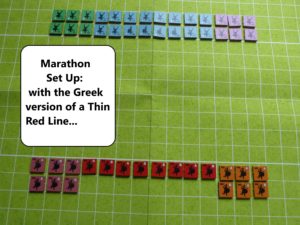 Of course, we are now at least fifteen hundred years back from events pertaining to the rival ambitions of Matilda and Stephen in England and Normandy, so the system was never going to be a direct port. What are the differences? First, the choice of a square grid for this game, whatever unfortunate associations it may suggest in terms of “wargames” of the past, does reflect part of the designer’s guiding philosophy for this work – that these armies were only capable of the most rudimentary manoeuvres, and in the resultant game, this is reflected in having the infantry moving like rooks on a chessboard – but with the restriction of no retrograde movement at all. Here we also encounter one of the several tricky little notions set into the framework – no unit being able to advance past the row position of the rearmost enemy unit. So, flank away by all means, but no shifting right round the back of an enemy wing (save for the ambush launched at Olpae). As for the tricky bit, if you hit a portion of an enemy flank with infantry, and that enemy wing then pushes forward, unless you have done the thing right, your infantry is going to be left high and dry – cannot move back and is effectively out of the fight for good. Doing it right means never sidle round the flank of a viable enemy wing without keeping that same wing engaged to its front. Cavalry, by contrast, has more licence to roam; so while the mounted arm is this game and this period is hardly akin to Darius’ Bactrians or Alexander’s Companions, being able to move in all directions (including diagonally) at any time means they will have their uses.
Of course, we are now at least fifteen hundred years back from events pertaining to the rival ambitions of Matilda and Stephen in England and Normandy, so the system was never going to be a direct port. What are the differences? First, the choice of a square grid for this game, whatever unfortunate associations it may suggest in terms of “wargames” of the past, does reflect part of the designer’s guiding philosophy for this work – that these armies were only capable of the most rudimentary manoeuvres, and in the resultant game, this is reflected in having the infantry moving like rooks on a chessboard – but with the restriction of no retrograde movement at all. Here we also encounter one of the several tricky little notions set into the framework – no unit being able to advance past the row position of the rearmost enemy unit. So, flank away by all means, but no shifting right round the back of an enemy wing (save for the ambush launched at Olpae). As for the tricky bit, if you hit a portion of an enemy flank with infantry, and that enemy wing then pushes forward, unless you have done the thing right, your infantry is going to be left high and dry – cannot move back and is effectively out of the fight for good. Doing it right means never sidle round the flank of a viable enemy wing without keeping that same wing engaged to its front. Cavalry, by contrast, has more licence to roam; so while the mounted arm is this game and this period is hardly akin to Darius’ Bactrians or Alexander’s Companions, being able to move in all directions (including diagonally) at any time means they will have their uses.
Another new factor here is the brittle unit – killing units in this model is usually a two-part operation consisting of first exhausting the enemy unit and then, while they are in that status, exhausting them again. A nice extra here is that some units display a double white band on their reverse (exhausted) side, and such units are out of the game the moment they flip. This works alongside a random draw of given unit types to build your scenario order of battle – a process that does permit the player to see how much brittle material they have in each wing but is accompanied by having to deploy after mixing everything up on its front side and so not knowing precisely where the bad stuff is going or where the leaders (units marked with a star on their reverse side) have ended up.
The number of unit types is limited – hoplite, heavy and light infantry, plus light cavalry. One issue I had with how this model works is that the only real difference between the infantry types is how easy they are to kill or how difficult they might find it to kill anything else. This might sound like enough, but light infantry, to offer one example, does not have anything at all they are good at. They move at the same rate and in the same limited directions as everything else, and that is it. What throws this into sharper relief is that the game has an abstracted skirmisher mechanism. Although this is a very commendable factor, keeping the game clear of fiddly units and the clutter of pot shots here and there, it gives those light units nothing to do at all in terms of any inherent tactical character.
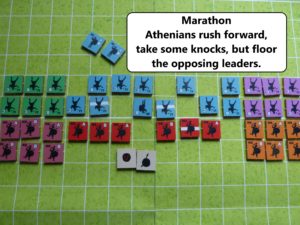 Skirmishing is simply reflected in two things – does an army have a skirmish factor, and depending on its value if it does, what chance does it have of hurting the foe during a skirmish command? Not all armies in the game have any skirmish ability at all – pure hoplite hosts are likely to have none, or next to none. But if your army does have this ability, it is simply a matter of issuing the relevant command, rolling a die, adding the skirmish value, and causing hurt on a total of eight or more. Wings rather than units have a skirmish zone extending three squares forward – you can launch missiles further, but with reduced effects. However, once the enemy is next to units of a given wing (note: you are slowed once you enter the actual zone for the first time), the skirmish ability is forfeited for the duration – the lightly-clad lads with the slings and the spears have all cleared off.
Skirmishing is simply reflected in two things – does an army have a skirmish factor, and depending on its value if it does, what chance does it have of hurting the foe during a skirmish command? Not all armies in the game have any skirmish ability at all – pure hoplite hosts are likely to have none, or next to none. But if your army does have this ability, it is simply a matter of issuing the relevant command, rolling a die, adding the skirmish value, and causing hurt on a total of eight or more. Wings rather than units have a skirmish zone extending three squares forward – you can launch missiles further, but with reduced effects. However, once the enemy is next to units of a given wing (note: you are slowed once you enter the actual zone for the first time), the skirmish ability is forfeited for the duration – the lightly-clad lads with the slings and the spears have all cleared off.
Compared to the medieval series (Shields and Swords II) the orders available here are even more limited and consist of Move, Combat, Rally, and Skirmish. These can be augmented by a bonus command to add more effect to whatever basic order you issued to a wing, and there is also the Strategos command that can get more of the army moving via the same order, but at the price of lowering the rally limit for the army – it is straining the engine, to make an analogy. The rally limit itself serves two functions: it defines how many rally attempts you can make in a turn when a rally command is in place, and it also provides a sense of basic army and command cohesion as if the level drops to zero (by killing army leaders or overuse of the Strategos command putting its own strain on things) that side loses the battle.
One sees these factors very much in play (or at least I did) during the Marathon scenario. In fact, this scenario now has the honour of being the shortest wargame I have ever played. To sum up, against a Persian host whose fragility is reflected in a poor rally limit of just two, and this against a Greek host that has the first turn and the initiative marker (to be explained a little later) and the benefit of a special scenario rule that permits the Greek player to launch everything forward in a once-a-game special double-move, the hoplites simply bundled into the Persians, whose own skirmish/missile response did nothing and then found their unfortunately placed leaders exposed upfront and precipitously wiped out.
I was not bothered by this – armies of a certain time could simply fall to pieces, and this one just happened to follow the pattern. On another day, had the Persians got some missile strikes and their leaders been somewhere other than wanting the best view of some very dangerous things getting nearer, it could have been different.
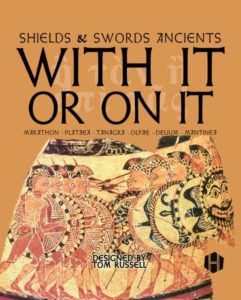 This brings us to an area of clear similarity between this game and the medieval series, which is the importance of getting the first blow in. Interestingly, many of the scenarios in this design (six in total) give the first player turn to one side but give the initiative marker to the other. What makes this so important is that a side that has both tempo and the initiative marker (think of it as being able to close and then spend the marker for a second turn for combat purposes) has a good chance of disjointing an enemy wing before it can respond – all the more so if the bonus command is played, making attacking combat that more deadly.
This brings us to an area of clear similarity between this game and the medieval series, which is the importance of getting the first blow in. Interestingly, many of the scenarios in this design (six in total) give the first player turn to one side but give the initiative marker to the other. What makes this so important is that a side that has both tempo and the initiative marker (think of it as being able to close and then spend the marker for a second turn for combat purposes) has a good chance of disjointing an enemy wing before it can respond – all the more so if the bonus command is played, making attacking combat that more deadly.
As in “House of Normandie” the command chits are deliberately arranged to create difficult “this or that” choices: so, for example, the combat command icon is on the opposite side of the marker that also has the move command – in other words, you can only choose one, and thus if you close without any provision to follow up immediately with combat (using initiative to go again with refreshed chits) you can become a sitting duck. Yes, combat can harm both sides, but if that first strike, ideally with the bonus chit added, does any significant amount of exhaustion damage, the defender, in their turn, will be spending their “tempo” simply trying to get some units rallied (easier said than done) rather than having any ability to hit back at least as hard as they have just been.
Permutations here can get complicated as the initiative will probably be swapped multiple times between the players and there is no accounting for bad luck die rolls, but as a general rule, if you can attack with effective force, you should not hold back.
Combat itself follows, in its own way, a path well-trodden since the days when SPI gave us the first look at ancient and medieval tactical warfare. Each warrior type/weapon class has advantages over some foes and weaknesses against others – rock, scissors, paper. Hoplites have an edge over everything save other hoplites (although Spartan hoplites sometimes get a scenario bonus), and such advantages are presented in combat die modifiers. Combat Class (printed on the units) is more to do with a sense of morale and fighting prowess – rated from A to C, Hoplites are never less than B and much else is either B or C. Flanking or being backed up with something viable in an adjacent space can augment Combat Class up to A+, while being part of a wrecked/exhausted wing can bring all but hoplites down to a D.
This all works perfectly well, save possibly for one aspect that gamers can make their own mind up about. This caveat pertains to the rout check procedure, which is triggered when a unit of any given wing is lost. At that precise moment, the owing player assesses that wing as a whole to see if any unit is lacking the requisite amount of support to stay in the fight. This is a variation on what one sees in “House of Normandie,” where deciding to hang around was linked to a range of possible factors – like having some friendly heavy horse units nearby. In “With It or On It”, however, a unit either needs two fresh units adjacent or at least for an adjacent fresh unit to qualify under the same criteria. Anything that fails is off the board and counts as eliminated.
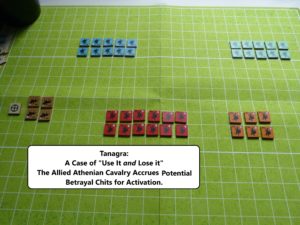 This all makes logical sense, but, given the square grid, these elements make aspects of the game rather geometrical. I thought of patterns of defence and territorial control on a Go board, to be honest, and I am never that keen on aspects of wargame play that have me thinking in a non-wargame way – in this instance, wondering if I have the units/pebbles in the right place followed by checking down chains of such positions to ensure everything is as bonded as possible. Related to this is a bit of a chafing contradiction between the instantaneousness of rout determination and the way in which rallying units in a sequence will help those making the attempt further along in the process – they will get modifiers based on the better composition of the wing if earlier attempts have gone well. In short, I am not entirely convinced as to why the two processes have to be based on determinations built around different time structures – instantaneous for rout, sequential for rally.
This all makes logical sense, but, given the square grid, these elements make aspects of the game rather geometrical. I thought of patterns of defence and territorial control on a Go board, to be honest, and I am never that keen on aspects of wargame play that have me thinking in a non-wargame way – in this instance, wondering if I have the units/pebbles in the right place followed by checking down chains of such positions to ensure everything is as bonded as possible. Related to this is a bit of a chafing contradiction between the instantaneousness of rout determination and the way in which rallying units in a sequence will help those making the attempt further along in the process – they will get modifiers based on the better composition of the wing if earlier attempts have gone well. In short, I am not entirely convinced as to why the two processes have to be based on determinations built around different time structures – instantaneous for rout, sequential for rally.
In mitigation the designer has taken on a tough subject here, namely looking to create a good game out of very simple battles. GMT’s “Hoplite” had precisely the same challenge, and while that game has a far longer set of rules with more detail pertaining to this thing or that thing, it still boils down to the presentation of conflict involving two armies banging into each other. A number of scenarios in “Hoplite” are hardly a gamer’s feast for the eyes, with the rival hosts arrayed in opposing single lines of double-hex counters, and nothing much to do but bang them together and see whose cohesion gives out first. This is not the fault of the designer but simply the nature of the beast.
But is that same beast in “With It or On It” coaxed into offering just a wee bit more? The answer is yes – up to a point. Each of the six battles has a certain amount of nuance, from command and wing modifications, through to ambush, treachery, and provision for a Spartan edge come the onset of the pell-mell. The game needs this, as with the best will in the world, one battle can look very much like another, so having the historical possibility of ambuscades and allied wings deciding to play politics or cash in their bribes lends a sense of character to each individual field. And overall, these provisions work well, and very much in the case of the doubt as to what might wander off the field or when is the best time to launch an ambush. Supporting mechanisms ramp up then tension here – points begin to fall into your opponent’s hands if there is too much ambush delay at Olpae, and at Tanagra, the Athenian player can seek to lessen the chance of their cavalry clearing off by filling the blind-draw pool with loyalty chits, but again, this comes at a cost.
Such additions will not overcome the sense of abstraction entirely, with unit size being mutable and big battles looking much the same as smaller ones. But then, this is the way the overall model has worked across its various iterations, and if you have acquired a liking for any of the related games, this probably will not bother you that much. And like those other titles, this is a breeze to learn, set-up, and play. The rules are short, and with few counters on the map, battle preparation is not likely to last more than a handful of minutes. Alongside the rules booklet is a second booklet containing the battle scenarios and a fairly extensive historical commentary. It also has a colour reproduction of a painting by Sir Lawrence Alma-Tadema, who, for a wonder (if you know the artist’s work), managed to depict some ancient ladies here with their clothes still on. What is missing, however, are any illustrated examples of play, and while this is not a difficult design, the game really would have benefited from a few of these. The designer has admitted on BGG that the wording of certain rules could have been a bit tighter, but I suspect that an in-game illustration here and there would have done a better job. A good instance of this is the rule referenced earlier preventing units of one side advancing past the deepest unit of the opposing army. The trouble is, the way it is written suggests unit behaviour which prevents any flanking attempts at all, and such was the gist of one BGG question on the game’s page. In response, Tom Russell supplied one very handy illustration of what was really meant – problem solved. I would dare suggest in such a context that the game’s literature needed a bit less historical commentary and some illustrated game examples instead.
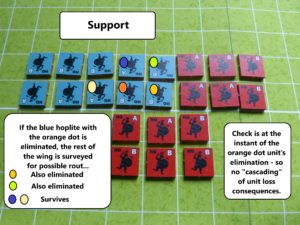 In summary, what I think we have here is one of those designs that will get some people interested because of what it does do, and prompt others to consider whether this is going to suit them because of the way it does those very things. Given that I have yet to encounter a Hollandspiele design that demands hours spent learning the rules, a bit of broad brushing is going to be inevitable. The questions then are: does this game have detail where it matters, and does it capture some essential element of what we think was going on in battles such as these? I think it does both – the inability to move the contingents in “fancy” ways; the reality of wings being locked once they come to blows; the rule provision for getting more combat “shove” from whatever is alongside or behind your embattled pieces, all these things create a valid ambience for a light game that plays about as fast as any wargame can possibly do. Yes, there are some areas which, perhaps, will not appeal to everyone. Those, I think, are worth mentioning, but how gamers react to them is entirely up to the gamer in question.
In summary, what I think we have here is one of those designs that will get some people interested because of what it does do, and prompt others to consider whether this is going to suit them because of the way it does those very things. Given that I have yet to encounter a Hollandspiele design that demands hours spent learning the rules, a bit of broad brushing is going to be inevitable. The questions then are: does this game have detail where it matters, and does it capture some essential element of what we think was going on in battles such as these? I think it does both – the inability to move the contingents in “fancy” ways; the reality of wings being locked once they come to blows; the rule provision for getting more combat “shove” from whatever is alongside or behind your embattled pieces, all these things create a valid ambience for a light game that plays about as fast as any wargame can possibly do. Yes, there are some areas which, perhaps, will not appeal to everyone. Those, I think, are worth mentioning, but how gamers react to them is entirely up to the gamer in question.
Paul Comben
Game Resources:
 With it or on It BGG Page
With it or on It BGG Page
With it or on it Home page


